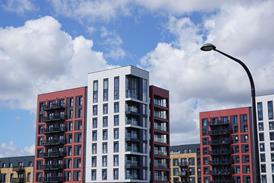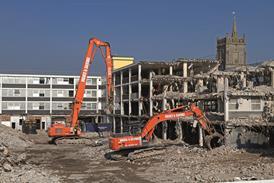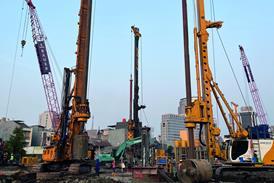A new borehole, located out of sight in the sub-basement, is now the principal feature which links the theatre with its subterranean designation. It will cool the auditorium, removing the need for refrigeration and reducing operating costs.
The heavily refurbished theatre, designed by architect RHWL, is a glass-and-brick post-modernist building which now has one of the largest stages in the country and the only one built specifically for dance.
The new theatre is not only about dance. The auditorium can be set up with a conventional proscenium stage, with a thrust stage, or in the round, or even for promenade performances. With the attached smaller Lilian Baylis theatre, rehearsal studios, a community and education centre, archive stores, a lecture theatre and gallery space all squeezed onto the site, Sadler's Wells is now a major centre for the arts in North London.
From the word go, running costs were seen as fundamental to the project's success, not only as a way of maintaining ticket prices at an affordable level, but essential for the theatre's economic survival. "The client was keen from the outset to minimise the building's reliance on refrigeration, heating and electricity," said Guy Battle of the project's services engineers Battle McCarthy.
The theatre has been redeveloped using funds largely provided by a National Lottery grant. Under the redevelopment, the 1931 theatre on the site was almost entirely demolished, leaving only the circle and upper circle. Retaining these features and incorporating them into the new building created problems for the design team.
Despite the majority of the building being new, the two seating levels effectively re-established the old building's floor and ceiling heights and, in so doing, made the already difficult job of servicing the theatre even harder.
Access to the auditorium is through a full- height glazed entrance foyer on the corner of Rosebury Avenue and Arlington Way. The foyer acts as the focal point for all pre-theatre activities with, on the ground floor, the ticket sales area, shop, a bar/food service area and access to the auditorium. On the upper levels it becomes a gallery space which gives access to the circle and upper circle and doubles up as the spill-out area for each of the bars.
Low emissivity glazing clads the foyer's main facade, while at its rear the foyer is lit by a full-height, south-west facing window. This bathes the space in the evening sun adding to the rich colours of the contemporary works of art adorning the walls.
A huge, suspended, liquid crystal glass screen dominates the foyer. During the day the screen is clear, maintaining the facade's transparency. At night, with an electric current passing through it, the screen is transformed into a huge semi-transparent, back-lit display which fills the foyer with dancing colours from advertisements tempting the audience back, while beaming the evening's sponsors to the outside world.
A massive bonus for the services design team must have been in designating the theatre, including the foyer and its bars, a no smoking area. A concession which no doubt contributed to their decision to include a naturally ventilated option for the space. This is accommodated by fitting windows on the quieter Arlington Way with actuators which operate under control of the building energy management system (bems).
A dedicated ahu feeds the bar areas, introducing fresh air at high level. This then spills out into the foyer to be exhausted by a roof- mounted extract fan.
In winter a massive lphw door curtain over the theatre's main entrance supplies the majority of heat to the space, this is topped-up by trench heating beneath the glazing. From the foyer, a set of double doors leads into the voluminous auditorium.
Despite its almost total rebuild, the auditorium's footprint has been maintained. However, unlike its predecessor, this reincarnation has no restricted sightlines or columns partially obstructing the view.
The stark, striking interior is clad in silvered, perforated, lacquered or painted mild steel sheets which clothe the auditorium's ceiling and walls. These conceal the services, stage lighting and adjustable acoustics.
The flat, wall-mounted panels are hinged to allow stage lighting to be sited behind. Panels on the ceiling have a more abstract form which conceals the lighting gantries and their associated walkways along with the air conditioning ductwork.
The ceiling panels to the rear of the third lighting bridge are motorised and can be lowered to close off the upper circle, for a reduced audience capacity.
Cooling the auditorium
The seated capacity of the auditorium has been retained at 1589. However, some of the seats can be removed creating an area where the stall's audience can stand, promenader style, giving a maximum design capacity of 1833 people.
A single roof-mounted ahu supplies 100% fresh air at 12 litres/s/person under seated conditions, and 8 litres/s/person under standing conditions.
In summer, with borehole water used to cool the air, the calculated off-coil temperature is 16·5°C. With a 1·5°C duct temperature increase, the design supply air temperature will be around 18°C for summer with predicted auditorium temperatures of between 23-25°C. In winter the auditorium design temperature is set at 22-24°C.
Air is delivered to the auditorium through three rows of high level plenum boxes, each with five stub-ducts which poke out between the aluminium mesh screens. Each row of plenums is fitted with a different set of air terminal devices reflecting the different air distribution needs (figure 1). Halton's swirl diffusers cover the row with the shortest throw, that nearest the audience, termed zone 2. Waterloo's jet nozzles are fitted to the middle and far rows (zone 1). The middle row, with its 10-13 m throw, is on diffuse setting while those with the longest throw, at 13-15 m, are on a jet setting.
To ensure their performance, Battle McCarthy tested the nozzles at Halton's laboratory in Finland. The configuration of five nozzles in close proximity produced some interesting results. The team discovered that the airstreams from the nozzles tended to reinforce each other where the two flows combined. The resulting throw was much further than manufacturer's data stated.
Another important issue was the gap between the mesh screens designed to obscure the ventilation system from the audience below. Too narrow a gap and the airstream would collide with the screen creating noise, too wide and the services become visible.
The nozzles have a rigid connection to the plenum boxes. To facilitate commissioning, each plenum is hinged at its top edge. A steel cable, fixed to the bottom edge, connects to a hand-operated winch which adjusts the angle of the plenum, allowing the nozzle's angle to the auditorium to be altered.
Fire regulations meant that the air supply for the entire auditorium had to be from one ahu. After some fairly severe acoustic treatment the supply air duct, from the roof- mounted ahu, enters through the auditorium roof slab. Even with only one ahu, each plenum has two flexible ducts feeding into it. These are connected to different sections of the main air supply duct to create a form of self-balancing system.
The intensive use of space around the auditorium meant that air distribution had to be above the auditoria. Although even here competition for space was fierce with theatre lighting and auditorium lighting. Particularly since keeping the air velocity below 2 m/s, to meet noise criteria, has resulted in some fairly monstrous ductwork diameters. A scale model ensured successful coordination of all the auditorium ceiling services.
Air is supplied to the otherwise stagnant spaces at the back of the circle and the rear of the auditorium from a spur duct (zone 3). Extract is from a single point at the rear of the auditorium above the upper circle.
In winter, a run-around coil transfers heat from the exhaust airstream to the supply air. Additional heat is supplied by three gas-fired boilers hidden away in a boilerhouse, tucked under the roof, on the third floor. Work on the auditorium was completed on time, ready for the opening night of 12 October 1998. The community part of the project is due for completion by Easter 1999.
Downloads
The auditorium
Other, Size 0 kb
Source
Building Sustainable Design



















